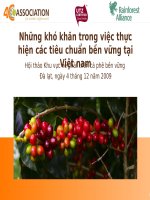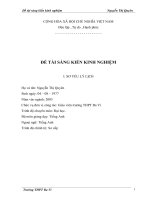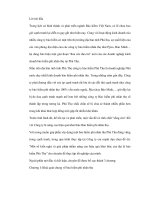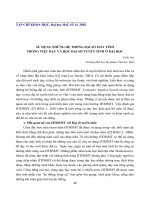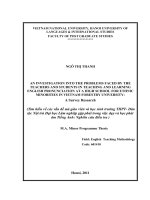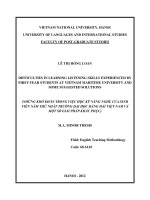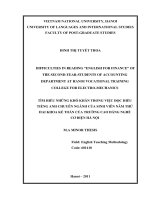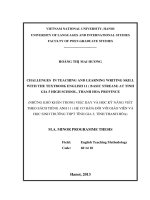Tìm hiểu những khó khăn trong việc dạy và học kĩ năng đọc hiểu theo giáo trình NewHeadway
Bạn đang xem bản rút gọn của tài liệu. Xem và tải ngay bản đầy đủ của tài liệu tại đây (1.47 MB, 59 trang )
VIETNAM NATIONAL UNIVERSITY, HANOI
UNIVERSITY OF LANGUAGES AND INTERNATIONAL STUDIES
FACULTY OF POSTGRADUATE STUDIES
NGUYỄN THỊ LAN HƯƠNG
A study of difficulties in teaching and learning
reading comprehension in the course book “New
Headway (Pre-Intermediate) to the first year
students at college of Broadcasting 1, Phu Ly city,
Ha Nam province and some solutions
(Tìm hiểu những khó khăn trong việc dạy và học kĩ năng đọc hiểu theo giáo
trình NewHeadway (Pre-Intermediate) cho sinh viên năm thứ 1 tai trường
cao đẳng Phát thanh- truyền hình 1,Thành phố Phủ lý, Tỉnh Hà Nam và một
số giải pháp khắc phục)
M.A MINOR PROGRAMME THESIS
Field: English Teaching Methodology
Code: 60.14.10
HANOI – 2011
VIETNAM NATIONAL UNIVERSITY, HANOI
UNIVERSITY OF LANGUAGES AND INTERNATIONAL STUDIES
FACULTY OF POSTGRADUATE STUDIES
NGUYỄN THỊ LAN HƯƠNG
A study of difficulties in teaching and learning
reading comprehension in the course book “New
Headway (Pre-Intermediate) to the first year
students at college of Broadcasting 1, Phu Ly city,
Ha Nam province and some solutions
(Tìm hiểu những khó khăn trong việc dạy và học kĩ năng đọc hiểu theo giáo
trình NewHeadway (Pre-Intermediate) cho sinh viên năm thứ 1 tai trường
cao đẳng Phát thanh- truyền hình 1,Thành phố Phủ lý, Tỉnh Hà Nam và một
số giải pháp khắc phục)
M.A MINOR PROGRAMME THESIS
Field: English Teaching Methodology
Code: 60.14.10
Supervisor: Nguyễn Thị Vượng, MA.
HANOI – 2011
iv
LIST OF TABLES
Table 1: Student's opinion on the course book "New Headway" (Pre-Intermediate)
Table 2: Difficulties revealed by the students
Table 3: Students' sources of difficulties and their desire from the teachers
v
TABLE OF CONTENT
page
Acknowledgement i
Abstract ii
List of tables i
INTRODUCTION
1. Rationale
2. Aims of the Study
3. Research Questions
4. Methods of the Study
5. Scope of the study
6. Design of the study
DEVELOPMENT
Chapter I: Theoretical background
1.1. Definition of Terminology
1.1.1. What is reading?
1.1.2.Reading comprehension
1.2. Stages in teaching reading skill
1.2.1 Pre-reading stage
1.2.2 While-reading stage
1.2.3 Post-reading stage
1.3. Reading approaches and skills
1.3.1. Intensive reading
1.3.2. Extensive reading
1.3.2.1. Skimming
1.3.2.2. Scanning
1.3.3. Factors connected with reading success
1.3.3.1. Physical condition
1.3.3.2. Speed of reading
1.3.3.3.Oral reading
1
1
1
2
2
2
3
4
4
4
4
5
5
6
6
6
7
7
7
8
8
8
9
9
9
vi
1.3.3.4. Vocabulary
1.3.3.5. Reading comprehension
1.3.3.6. Ability to use references
1.3.3.7. Pattern of reading
1.4. Difficulties of the second language reading comprehension process
1.4.1. Reading skill problem
1.4.2. Language problems
1.4.3. Cultural background knowledge
1.4.4. Learner-centeredness in foreign language education
Chapter II: An introduction of the course book “New Headway " (Pre-
Intermediate) and the current situation of teaching and learning this course book
2.1 General description of the course book “New Headway”(Pre-Intermediate)
2.1.1 Objectives
2.1.2 Topics, Terminologies and grammatical structures
2.1.3 Characteristics of reading texts and reading exercises
2.2. Current situation of teaching the course book
2.2.1. Length of the course and time allocation for reading skill
2.2.2. Teaching staff and teaching methods
2.2.3. Teaching facilities
2.3. Current situation of learning the course book
2.3.1. Students’ background
2.3.2. Students’ learning condition
2.3.3. Students’ attitude to learning English
Chapter III: The Study
3.1.The context of the study
3.2. The subject
3.3.Data collection methods
3.4.Data collection procedure
3.5. Data analysis and discussion
3.5.1. Discussion of the result collected by means of the questionnaire
3.5.1.1. Student's opinion on the course book "New Headway"( Pre-
9
9
10
10
10
10
11
12
13
15
15
15
15
16
16
17
17
17
18
18
18
18
19
19
19
19
20
21
21
vii
Intermediate)
3.5.1.2. Difficulties revealed by the students
3.5.1.3. Students' sources of difficulties and their desire from the
teachers
3.5.2. Discussion of the result collected by means of the interview,
classroom, observation and journal keeping
3.5.2.1. Teacher's opinion on the course "New Headway" (Pre-
Intermediate)
3.5.2.2. Teacher's difficulties in teaching reading English in the
course book "New Headway" (Pre-Intermediate)
3.5.3. Possible solutions
3.5.3.1. Training students to become efficient readers
3.5.3.2. Encouraging students to have extensive reading habit
3.5.3.3. Making students fully aware of their purpose of reading
3.5.3.4. Improving background knowledge for English teachers
. 3.5.3.5. Improving teachers' classroom techniques
3.5.3.6. Equipping teaching facilities
3.5.3.7. Adapting the course book
CONCLUSION
1.Summary of the study
2.Limitations and suggestions for further study
REFERENCES
21
22
23
25
25
26
29
30
30
31
31
32
33
34
36
36
37
39
APPENDICES
Appendix 1: Interview questions for teachers I
Appendix 2: Questionnaire for students II
Appendix 3:Content of the course book "New Headway" (Pre-Intermediate) IV
Appendix 4: Unit 3: The reading text" The name's Bond, James Bond" V
(pages 26-27)
Appendix 5: Unit 4: The reading text" Markets around the world" VII
viii
(pages 34-35)
Appendix 6: Unit 8: The reading text "Jobs for the boys… and girls" X
(pages 66-67)
1
INTRODUCTION
1. Rationale
In the college of Broadcasting 1, Phu Ly city, Ha Nam Province, where the author
works, there are some departments such as: Journalism, Accounting, Information
Technology, Engineering, Telecommunication.
English is a compulsory subject at school. It is taught with the purpose that students will
use it effectively to fulfill their daily work in the future so it receives great deal concern of
teachers and students here. In English, students have to learn both General English and
English for Specific Purposes.
General English play a very important role with the object to enhance the first year
students’ general knowledge in English. Because General English will support students
general knowledge to learn further English. Moreover, students in the college of
Broadcasting 1 will use English as a means of communication and receive information
when they graduate.
Basing on the characteristics of the future work, students must study English with four
related skills: listening, speaking, reading and writing. In teaching and learning English as
a foreign language in Vietnam, reading has always received a great deal attention. This is
understandable, English is learnt and taught in non-English environment, so reading is not
only one of the four language skills that students of English need to acquire but also a
means of further study.
Although in the course book “New Headway” four skills are taught, reading is more
important than other three skills because students have to take the examinations which are
grammar and reading based. However, the students’ reading proficiency is not satisfactory.
That is because teachers and students have difficulties in receiving especially reading skill
though this course book has used for some terms. If those difficulties are not found out and
no solutions to overcome are given, it is certain that reading class cannot be successful.
Despite the above mention reason, no study on this matter has been carried out. It has
encouraged the author to do the research.
2. Aims and significance of the study
The study is aimed at:
2
1. investigating the areas of difficulties that students and teachers are coping with
in their daily of teaching and learning reading comprehension in the course book "New
Headway" (Pre-Intermediate) for the first year students.
2. offering some solutions to overcome difficulties encountered.
The study is carried out in terms of both theory and practice with a hope to be of some help
to the improvement of reading comprehension teaching and learning efficiency for the first
year students in the college of Broadcasting 1
3. Research questions
In order to achieve the above aims, the study concentrated answering the research
questions:
- What are difficulties experienced by teachers who are teaching and first year students
who are learning reading comprehension in the course book "New Headway" (Pre-
Intermediate) in the college of Broadcasting 1 ?
- What are feasible solutions to overcome those difficulties?
In order to find out the answers to the research questions, many sub-questions shall be deal
with:
- What are teachers' and students' opinions on the course book "New Headway" (Pre-
Intermediate)?
- What are difficulties in learning Reading comprehension in this course book
revealed by students and is there any relation between students' difficulties and
their teachers’ teaching method?
- What are difficulties in teaching Reading comprehension in this course book
revealed by teachers?
Once the difficulties are found, appropriate solutions to overcome those difficulties will be
suggested.
4. Scope of the study
This study limits itself to the investigation of
- a sample of the first year students
- Teachers of English
- Reading comprehension in the course book "New Headway" (Pre-Intermediate)
5. Methods of the study
3
In order to get the most exact information for the study, two methods of research
(qualitative and quantitative) were employed with the following instruments:
- survey questionnaires to students
- classroom observation
- informal interview with teachers of English
- journal keeping
The data can be formally and informally recorded. Interview and classroom observation
are used to record information from teachers. A survey questionnaire to students will
identify common difficulties the students encounter in their reading comprehension.
6. Design of the study
The study will be organized into 3 parts:
Part I: Introduction: Presents the rationale, aims and significance of the study, research
question, scope of the study and methods of the study.
Part II: Development: This part consists of 3 chapters:
Chapter 1: Discusses the theoretical background, which is relevant to the purpose
of the study.
Chapter 2: Gives a brief introduction on the course book used in this study “New
Headway” (Pre-Intermediate) and current situation of teaching and learning this course
book.
Chapter 3: Deals with the study: context of the study, the subject, data collection
method, data collection procedure. Also in this chapter, the data will be analyzed and
the findings of the study will reveals teachers’ and first year students’ difficulties in
teaching and learning reading comprehension of General English. Basing on
difficulties, solutions to overcome will be suggested.
Part 3: Conclusion: Summaries the study and offers some suggestions for further
study.
4
DEVELOPMENT
Chapter I: Theoretical background
1.1. Definition of Terminology
1.1.1. What is reading?
In our daily life, we spend time reading books, newspapers, novels or stories because
we find them interesting and useful. When reading, we understanding the texts, we
analyze and find its meaning, give out meaningful conclusion. But no one can define
exactly what reading is. This question attracts much attention and researchers have
defined reading in various ideas. According to Goodman (1971:135), reading is “a
psycholinguistics process by which the reader, a language user, reconstructs, as best as
he can, a message which has been encoded by a writer as a graphic display. Goodman
thought that this act of reconstruction is reviewed as “a cyclical process of sampling,
predicting, testing and confirming”.
William (1984:3) had the same view on reading, especially on the act of reconstruction
as Goodman. He argues that: “written texts, then, often contain more than we need to
understand them. The efficient reader makes use of this to take what he needs, and no
more, to obtain meaning. His opinion is shared by Nuttall and Grellet. The former
asserts that “reading is getting a message from the text”.
Harmer (1989:153) considers reading as a mechanical process that “eyes receive the
message and the brain then has to work out the significance of the message”. He not
only focuses on two actions that dominated by the eyes and the brain but also the speed
of the process “a reading text moves at a speed of the reader” which means that the
reader who describes how fast he wants to read the text.
Sharing the same view, Smith (1985:102) defined “reading is understanding the
author’s thought”. It means that the readers “read the author’s mind not the author’s
words”.
One more definition of reading is offered by Allen and Vallete (1977:249). They
thought that “reading is developmental process”. We learn reading not only to know
how to read, to master the symbols, the language, grammar, etc used in the text but
5
also to understand the ideas, the information expressed in that text or to develop the
ability reconstructing its contents in our own words
In short, from these opinions above, it is clear that no one can give all the ideas and
features of what reading is. Each definition reflects what reading means as seen from
the scholar’s own view. However, all definitions reveal their common feature that is the
nature of reading. Moreover, the definition “reading is understanding the author’s
thought” seems to be preferable.
1.1.2. What is Reading Comprehension?
Reading comprehension plays an important role in learning a foreign language.
Reading comprehension can be understood as the ability to get the required information
from the text as efficiently a possible. In the reading process, there are three elements
appearing: the text being read, the background knowledge of the reader and the
contextual aspects relevant for interpreting the text.
Swam (1975:1) stated that when we say “a student is good at comprehension we mean
that he can read accurately and efficiently, so as to get the maximum information a text
with the minimum of understanding”.
In the same view, Richard and Thomas (1987:9) claim that “reading comprehension is
best described as understanding between the author and the reader. Sharing these ideas,
Grellete (1981) takes the point that “reading comprehension or understanding a written
text means extracting the required information from it as efficiently as possible”.
These above opinions are not exactly the same, but they all show that reading
comprehension is much more than pronouncing words correctly or simply knowing
what the author intends. It is a process in which the readers can recognize the graphic
form and understand the relation between the writing and the meaning. In the other
words, after reading students can find the way to bettering their grammar, words,
pronunciation and understanding the content of the text and use it in their real life.
It is really important for us to understand what reading comprehension is. For the
teachers, who teach reading, a profound understanding about the nature of reading
comprehension may help them find out the students’ difficulties of learning reading.
1.2. Stages in teaching reading skill
6
It is common knowledge that a reading lesson consists of three important stages: pre-
reading, while reading and post reading. Obviously, each stage has its own
characteristics and time allocation.
1.2.1 Pre-reading stage
This stage is carried out before the students begin reading the text. It plays essential
part in the whole process of a reading lesson because it is difficult to ask students to
read unseen text without preparation which involves such activities as pre-reading
questions, pre-teaching vocabulary. According to William (1984; 37), the purposes of
the pre-reading stage are:
- to arouse students’ interests in the topic
- to motivate learners by giving a reason for reading
- to provide some language preparation for the text
Normally, pre-reading stage often lasts about one-tenth of the time allocation for the
whole lesson. However, depending on each lesson, it may last shorter or longer. Before
delivering activities for this stage, the teacher needs to pay careful attention to the
objectives of the lesson, the situation of teaching and learning, the students’ needs for
the fact that “a good beginning makes a good ending”.
1.2.2 While-reading stage
William (1984:38) states that while reading stage is the main part of a reading lesson
with the following specific aims:
- to help understanding of the writer’s purpose
- to help understanding of the text structure
- to clarify text content
The teacher, at the while reading stage, needs to help their students comprehend the
content thoroughly while the students have to apply to the best their reading skills like
skimming, scanning, guessing, etc to understand the text as well as the writer’s
purposes containing through the reading text. Time allocation for this stage is nearly
two-third of the whole lesson.
1.2.3 Post-reading stage
7
It is the last phrase of a reading lesson so it is the time for students' production. This
stage will reflect how well students comprehend the text. In William's view (1984:39)
"the post-reading stage is aimed at consolidating or reflecting upon what has been read
and relating the text to the learners' own knowledge, interests or views".
In conclusion, these above mentioned stages are essential for a reading lesson.
However, it is not necessary to carry out all these stages mechanically on every
occasion. Depending on the purposes of reading lesson, the teacher may apply these
stages as well as allocate each stage appropriately
1.3. Reading approaches and skills
1.3.1. Intensive reading
Nutall (1982:36) defines: “Intensive reading involves approaching the text
under the guidance of a teacher or a task which forces the students to focus on the
text”. Thus, intensive reading is usually a classroom- oriented activity in which
students focus on the linguistic or semantic details of a message to extract specific
information. Intensive reading calls students’ attention to grammatical forms, discourse
markers and other surface structures. Intensive reading aims at understanding not only
of what the texts mean, but of how the meaning is produced.
The “how” and the “what” are equally received. Consequently, intensive
reading lessons train primarily strategies for students to encounter with other texts.
There are two sub-distinction of intensive reading; they are skills-based and text-based.
While the former focuses on a particular skill (for example: distinguish the main idea
of a text from the details, inferences from content), the later, on the other hand, refers
to the lesson focus in the text itself and students try to understand it as fully as
necessary, using all their acquired skills.
1.3.2. Extensive reading
The purpose of extensive reading is to train students to read directly and fluently
in a foreign language for his own enjoyment, without the aid of the teacher to achieve a
general sense of the text, skimming for the gist and scanning for some key details.
Extensive reading is a relatively rapid and efficient process of reading a text for global
or general meaning.
8
1.3.2.1. Skimming
Skimming is the act of looking some prominent parts of an article. By catching
a few words only, the readers can get an overall picture of the “what”, of course only
on a rather superficial level. Because of its nature, the key to skimming is to know
where to find the main idea of different paragraphs and to be able to synthesize them
by way of generalization.
1.3.2.2. Scanning
Scanning is another useful skill to locate specific item of information that we
need and often we do not even follow the linearity of the message, but focus on the
needed information. In contrast with skimming, scanning is far more limited since it
only means retrieving needed information.
In the teaching of reading as a language skill, Kenedy and Bolitho (1991:74)
designate some necessary reading skills: skimming, scanning, reference skill, relating
diagram to text, predicting and sequencing the structure of a text and reading notices
and instructions. However, students will never read efficiently unless they can adapt
their reading speed and techniques to their aims when reading.
So the main conclusion to be drawn from all above mentioned is the students
would waste time and fail to remember points of important to them because they would
absorb too much non-essential information if they are not helped to read appropriately.
Hence, to understand a text efficiently, the readers should not select types of reading
separately but in combination of purpose-oriented strategies so that they can cope with
more and more sophisticated texts and tasks and deal with them efficiently: quickly,
appropriately and skillfully.
1.3.3. Factors connected with reading success
There are 7 main factors connected with reading success:
- Physical condition
- Speed of reading
- Oral reading
- Vocabulary
- Reading comprehension
9
- Ability to use references
- Pattern of reading
All these relate to the success for students in developing the skills. habits and
attitudes that contribute to efficient reading.
1.3.3.1. Physical condition
Have the students’ eyes and ears checked? Make sure that the students’ vision
and hearing are reasonable good. If the print looks blurred to them, their vision are
probably not as good as it should be. If they have frequent headache, they may have
eyestrain. This eyes train may be relieved by properly fitted glasses.
Read at the same time everyday, make sure that your reading light is right; and
at last read in a quiet place.
1.3.3.2. Speed of reading
Reading speed depends on both on reading habits and on reading skills. If the
students move their lips while reading, this slows down their rate. If they read a group
of words instead of a single word at a glance, this steps up their reading speed.
1.3.3.3.Oral reading
To be a good reader, we must be able to read aloud with clarify and expression.
Do not stumble over words or read in a monotone. Read so that our listeners
understand and enjoy what we are reading.
1.3.3.4. Vocabulary
The better our vocabulary is, the better our reading is. Whether our vocabulary
now is good or poor, we should keep on trying to learn the meaning of new words.
When we come across a word we do not know, do not stop reading. Continue reading
until we finish the text. Then reread the sentence in which the new word appears. Try
to get the word’s meaning from the words around it. If we still are not sure what the
word means, look it up in the dictionary. Always compare the difference meaning and
select the one that fits the sentence we are reading.
1.3.3.5. Reading comprehension
Reading comprehension is not just one ability. It is any different abilities. These
abilities include a long and varied list of reading skills and habits.
10
To develop good comprehension, pay close attention to what we read. Read to
meet our own well-defined purpose. Relate what we read to our own experience. From
a critical attitude toward what we read. And finally, organize the information we get
from reading.
1.3.3.6. Ability to use references
If we want to be a good reader, become familiar with reference materials such
as dictionaries, encyclopedias, yearbooks, atlases and the library’s card catalog. Kear
where to find these references and how to use them.
1.3.3.7. Pattern of reading
If we would be an effective reader, develop a pattern a reading that covers a
wide variety of interests. Read magazine article and books on different subjects. Read
both fiction and non-fiction. Skim a newspaper and read carefully the most parts. Make
good use of the public library.
1.4. Difficulties of the second language reading comprehension process
1.4.1. Reading skill problem
If the reading ability of a reader in his mother tongue is poor, he can not read well in a
foreign language. According to Anderson (1984), the students cannot read adequately
in English is that they are not able to read adequately in the native language.
The interaction between the first language and the second language reading ability is
further clarified by several researchers. For example, Bernhart and Kamil (1975:17)
assume that “reading performance in a second language is largely shared with reading
ability in a first language”
While investigating the transferability of students’ L1 reading strategies to L2 reading,
Sarig (1987: 118) also asserts that “the same reading strategies types account for
success and failure in both languages to almost the same extent. It can be concluded,
then, that reading process from the first language appears to transfer to the foreign
language”
Reading is an active skill, involving guessing and predicting. Students’ limited reading
skill creates many problems. Very frequently, students do not know how to use
11
different reading skill, how to use appropriate ways to move their eyes from word
group to word group.
Students’ limited reading skills create many problems such as reading slowly, failing to
understand and summarize main ideas of the reading text, unable to guest or predict
meaning of the words or phrases used in that context, etc
Therefore, such students find it hard to be successful in their reading. They cannot
understand the text thoroughly and those are reasons why they do not want to keep on
reading. In addition, learners' motivation reason toward reading is also an important
factor in reading process. It may affect reading result such as good speed, enjoyment
and comprehension. Lacking of motivation, the readers do not want to read more.
It is common that there are new words, new structures in a reading text for every
language learner. If the learner has no good reading ability, he will read the text with
less understanding and he will get discouraged and will not want to keep on reading
gradually. Therefore, how to help learner of a foreign language to read better is closely
related to their reading.
1.4.2. Language problems
Yorio (1971) gives out a contrary view to reading problems. He argues that reading
problems of foreign language learners are largely due to the knowledge of the target
language to mother tongue interference in the reading process.
According to Alderson (1984) and Clarke (1980), Reading problems of foreign
language learners are due largely to imperfect knowledge of the target language and to
mother tongue interference in the reading process. A lack of appropriate linguistic
knowledge contrasts the transfer of reading skills and strategies from the first language
to the second language. Dealing with the text, readers have to work with unfamiliar and
difficult topics. These called “text problem”.
The second but not less important kind of problem is the "vocabulary problem". As
everyone knows, grammatical knowledge accounts for a great deal of competence in
reading. However, knowledge of vocabulary is a great deal more important as a factor
of reading comprehension than awareness of grammatical structures (O'Donnel, 1961:
313-316).
12
Second language readers may lack knowledge of English grammar and syntax and
therefore, may read word by word. They may encounter too much unfamiliar
vocabulary to grasp the overall concept conveyed in the sentence. They are also
changed when reading idiomatic expressions and unfamiliar grammatical constructions.
In addition, second language readers may have difficulties with more complex and
compound sentences. They may loose the meaning of references within the text, such
as with frequent use of pronouns. Pronoun usage may be different or less frequent in
the native language. Connectives may be overlooked or misunderstood so they loose
the relationships between concepts and ideas.
Besides, readers may encounter a lot of difficulties in dealing with proverbs and
idioms, synonyms and antonyms, poly-semantics and technical vocabulary. Metaphor,
metonymy, and other types of transference of meaning also cause great difficulty for
readers.
1.4.3. Cultural background knowledge
Several studies on reading skills indicate that apart from language problems and
reading problems, cultural background knowledge also affect students' reading ability.
According to Fries (1963) meaning at the social level is the meaning that transcends the
language code and is related to the background knowledge of the native speakers of
that code. Comprehension of the total meaning of a sentence occurs only when the
linguistic meaning of the sentence is fitted into "a social framework of organized
information". This idea is echoed by other researchers who have stated that readers will
have different levels of comprehension of the same text because they start from
different positions. They interpret texts differently because of the differences in the
high-level cultural schemata that were activated.
Carell (1981) demonstrated the effect of cultural knowledge on the product of
comprehension, appealing to the processes of distortion and elaboration to account for
the differences between a recall of text and the original text. Readers facing with
unfamiliar cultural content may mistranslate or misinterpret the text according to their
own cultural experiences.
13
Reading comprehension is a function of cultural background knowledge. If readers
process the schema assumed by the writer, they understand what is stated and
effortlessly make the inferences intended.
As Hudson (1982:9) puts it: "the reading problems of the second language readers are
not due to an absence of attempts at fitting and providing specific schemata rather,
problem lies in projecting appropriate schemata"
1.4.4. Learner-centeredness in foreign education
Recently, in the field of second /foreign language education there has been a shift in
focus from the teacher to the learner. There are two reasons of this shift: learners are
now the center of the language teaching and learning process and learners learn better if
the teacher's teaching style matches their learning styles.
Nunan (1990) point out that learners learn better if teachers know how to carter for all
individual differences and need. What is more, learners learn better if the teachers
know of their learning difficulties and help them to cope with the difficulties.
Nunan (2000: 11) defines learner-centered classrooms as the places where "key
decisions about what is taught, how it will be taught, when it will be taught, and how it
will be accessed will be made with reference to their learner
In a learner-center curriculum, information about learners from learners is used to
answer when and how to teach what. Nunan (2000) elaborates several stages of
negotiating a learner-centered curriculum; making instructional goals clear to learners;
allowing learners to create their own goals, encouraging learners to use the second
language outside the classroom; raising awareness of learning processes; helping
learners identify their own preferred styles and strategies; encouraging learners to
become teachers; encouraging learners to become researchers. The learner-centered
curriculum also describes well how to promote learners autonomy as an educational
goal at an institutional level.
One important implication of learner-centeredness for instruction is that teachers need
to guide student to create their own understandings. They accomplish this by utilizing
students' background of understanding, cooperative learning, authentic learning
problems, and active student engagement in the learning process
14
Summary:
Through the brief literature review, it is obvious that there are so many factors
involved in the L2 reading comprehension process. From what have been discussed it
can be concluded that there are three main factors that affect reading comprehension:
(1) reading skill, (2) language proficiency or language knowledge, and (3) cultural
background knowledge.
Also, the literature review emphasizes the need to understand how students talk about
their difficulties and problem if learner-centered teaching is desired.
Insights into this process highlights reading difficulties. Having looked at the literature
Review of reading comprehension, an application in the course book will be presented
hereby.
15
Chapter II: An introduction of the course book “New Headway" (Pre-
Intermediate) and the current situation of teaching and learning this course book
2.1 General description of the course book “New Headway” (Pre-Intermediate)
2.1.1 Objectives
In the college of Broadcasting 1, students learn English with the intention of using it as a
means to complete their future job requirements. They use English to communicate so the
course book "New Headway" (Pre-Intermediate) has been chosen to be the official course
book for the first year students before they continue learning ESP.
The book was written by Liz and John Soars. As can be seen in the title of the book, it
reveals a new way of learning English. The book was written with the purpose of providing
general knowledge for different kinds of learners: those who have never learnt English;
those who are not good at English; those who want to improve their English. At the end of
the course, students should be able to:
- enrich their vocabulary
- enrich their general knowledge
- using skills to communicate successfully
- have basic knowledge to continue their study of ESP
- get a certificate to get a job
For all the reasons above, our college chose this course for the first year students to
encourage students in learning English.
2.1.2 Topics, Terminologies and grammatical structures
The book covers 12 topics (in 12 units) about general knowledge (see Appendix 3). Each
unit has different length depending on the complexity of the subject matter. In each unit,
concrete objectives are revealed to the title of the unit.
For example, the objectives of Unit 1, the title is “getting to know you” and the reading
text is “A blind date”. After reading, students:
- have some knowledge about star signs
- can take a blind date
- have vocabulary bout personality and describing adjectives
Terminologies can be classified into two main groups: single and compound terms. Single
terms are made up of one word, usually a noun or a verb. Eg: Aquarius ( sao Bao Bình),
Tarus ( sao Kim Ngưu), lasagne ( món bột với cà chua và nước sốt hấp chung), diode (ống
16
hai cực) where as compound terms are the ones which consists of two or more than two
words. Eg: blind date (cuộc gặp giữa 2 người khác phái mà trước đó chưa hề quen biết),
back pack (ba lô đeo trên vai ), floating market (chợ nổi), carpet souk (mỗi loại thảm chỉ có
một cái duy nhất)…
About grammatical structure, it will cover three sub-units: words, sentences and tenses.
Many words in the books exist in the form of stem (scence, temple, mess ) , sometimes
use prefixes (repay, dislike, impolite…) or suffixes (receivable, healthy, useless, romantic,
personal )
Sentence types in the book are of various types: simple and complex sentences are used
regularly. Eg: "At 3.30 he was dreaming, not very peacefully, of these black coated men
with red eyes and angry white teeth. James Bond took his gun from under his pillow, got
quietly out of the bed, and crept slowly along the wall toward the window"(Unit 3, page
26).
The sentences are presented in both active and passive voice. Eg: "Nobody would give
them money for their project, so they used their credit cards and bought as much computer
memory as possible. Then, in 1998, they were given a cheque for $100,000, and they
started their own company." (Unit 10, page 83).
2.1.3 Characteristics of reading texts and reading exercises
The organization of information in reading texts of this course book shares common
characteristics of other reading texts, has its own characteristics: the information is
grouped into themes.
The exercises in the reading comprehension are divided into some types:
- gap- fill
- multiple choice
- matching
- True-False
- short answer
- complete sentence
2.2. Current situation of teaching the course book
2.2.1. Length of the course and time allocation for reading skill
English for communicating is introduced to the first year students in the college of
Broadcasting 1. They study the course book "New Headway" (Pre-Intermediate). The total
17
time for the course book is 60 periods (= 4 credits) .The course book covers 12 units. And
they learn the book during all the term and each period lasts 45 minutes.
Each unit lasts 4-6 periods depending on the length and difficulty of its content. And
reading is one of four parts in each unit so the time for this skill in each lesson is one
fourth. So to apply all stages in reading lesson is not easy.
2.2.2. Teaching staff and teaching methods
The English teaching staff at the college of Broadcasting 1 consists of 4 official teachers at
the age from 25 to 35. All the teachers have university diploma from different universities
in Vietnam. At present, 2 out of 4 teachers have done MA courses in Hanoi University of
foreign studies and one of them is doing an MA course in University of Language and
International studies.
The number of teachers are limited and the number of students are great so it is certain that
teachers must teach many classes. Classes are usually conducted in the form of lectures,
with most of the time the teachers playing the keys role in the classroom, being the main
speakers working through the text. The teachers explain new words, terms and even
translate some difficult texts into Vietnamese.
Though, the teachers are always aware of the new trend in teaching method nowadays:
Learner- center approach, they try to give their students independence in studying by
asking them to work through the texts or discuss subject matters in groups, giving them
some instructions before asking them make presentation in front of the class. Students at
that time have to play the role of the teacher, giving lecture to the whole class and they feel
highly motivated in learning.
However, only one or two teachers can do these. The rest of teachers write new words or
structures on the blackboard and the meaning of new words is provided right way without
any requirement for students' prediction or guessing from the text. Students are then
ordered to read new words aloud one by one frequently after the teachers.
After that they ask students to read the text for the first time before doing tasks. Students
are always passive and only ask the teachers questions when they encounter difficult
structures or words that they can not find in the dictionary. And the success rests on how
flexible and adaptable the individual teacher is to respond to the requirement of the new
teaching situation.
2.2.3. Teaching facilities
18
Teaching facilities are considered significant and may affect the teaching process
positively or negatively. In general, the teaching facilities in the college of Broadcasting 1
are poorly equipped. There is no laboratory and there is one library but it mainly provides a
few books of English. Neither, overhead projector nor projector is equipped in classrooms
except in Informatics class or Engineering class. The equipment in classroom is very
simple and traditional. A board, chalk, cassette player and textbook are main teaching
equipments in every class.
2.3. Current situation of learning the course book
2.3.1. Students’ background
Most of learners of the course book "New Headway" (Pre-Intermediate) are full
time students at the first year, aging from 18-19. They come from different parts of the
country with different level of English. Every year our college has about 500 first year
students. Some students are good at English, some have never learnt English before and
most of them have learnt English as a subject in high school but they are not keen on it.
Students are divided into classes from 40 to 60 students. Although they have different
levels of English, they all learn the course book "New Headway "(Pre-Intermediate) in the
first year.
2.3.2. Students’ learning condition
The students' condition of learning is not good enough. A few students have
dictionaries to learn English. Moreover, most of students live far from family so the places
to live and learn are badly-equipped. They mainly get the knowledge from the textbook
without referent books meanwhile the library of the school is poor. Because of this it
affects their study and result at the final exam.
2.3.3. Students’ attitude to learning English
When students were in high school they mainly learnt English for passing the final
exam in each term or at the end of the school year. So they did not care how to get
knowledge and how to communicate by English. They found English unnecessary and
their ability in general was very limited.
But now English is taught in 3 terms with different levels and it is an important
subject for them at school as well as in the future job so they are well aware of their
purpose of learning, they become hard working and patient.

